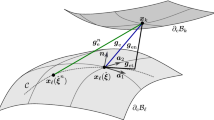Osteoarthritis and osteonecrosis of the femoral head are serious diseases that require surgical treatment (endoprosthetics (EP)). Aseptic loosening of the femoral component of the implant is a consequence of the micro-destruction of bone tissue in the contact area. The mechanical behavior in the zone of contacting materials during EP is determined by the morphology of the surfaces. To study the effect of the roughness of contacting elements, computer modeling was used. A part of the femur with a pin from a superficial endoprosthesis was considered. The mechanical behavior of the model samples was studied under loading similar to the physiological one. Nonlinear features in the mechanical behavior of model samples with different surface roughnesses are revealed. It has been found that the most optimal bone roughness is about 0.2 mm.
Similar content being viewed by others
References
D. Sakagoshi, T. Kabata, Y. Umemoto, et al., J. Arthroplasty, 25, 1282–1289 (2010); DOI: https://doi.org/10.1016/j.arth.2009.09.002.
Y. Tyson, C. Hillman, N. Majenburg, et al., Acta Orthop., 92, 143–150 (2021); DOI: https://doi.org/10.1080/17453674.2020.1846956.
J. M. Smolders, A. Hol, T. Rijnders, et al., J. Bone Joint Surg. Br., 92, 1509–1514 (2010); DOI: https://doi.org/10.1302/0301-620X.92B11.24785.
J. C. Webb and R. F. Spencer, J. Bone Joint Surg. Br., 89, 851–857 (2007); DOI: https://doi.org/10.1302/0301-620X.89B7.19148.
S. J. Breusch and H. Malchau, in: The Well-Cemented Total Hip Arthroplasty – Theory and Practice, S. J. Breusch and H. Malchau, eds., Springer Medizin Verlag, Heidelberg (2005), pp. 146–149.
H. Malchau, P. Herberts, T. Eisler, et al., J. Bone Joint Surg. Am., 84, 2–20 (2002); DOI: https://doi.org/10.2106/00004623-200200002-00002.
G. Lewis, J. Biomed. Mater. Res. 38, 155–188 (1997); DOI: https://doi.org/10.1002/(sici)1097-4636(199722)38:2<155::aidjbm10>3.0.co;2-c.
M. Sundfeldt, L. V. Carlsson, C. B. Johansson, et al., Acta Orthop., 77, 177–197 (2006); DOI: https://doi.org/10.1080/17453670610045902.
K. Mohemi, T. Ahmadi, A., Jafarzadeh, et al., Phys. Mesomech., 25, 85–96 (2022); DOI: https://doi.org/10.1134/S1029959922010106
S. V. Shil’ko, D. A. Chernous, and S. V. Panin, Phys. Mesomech., 26, 93–99 (2023); DOI: https://doi.org/10.1134/S1029959923010101.
B. Lennon, J. R. Britton, R. F. MacNiocaill, et al., J. Orthop. Res., 25, 779–788 (2007); DOI: https://doi.org/10.1002/jor.20346.
G. M. Eremina and A. Yu. Smolin, Comput. Methods Programs Biomed., 200, 105929 (2021); DOI: https://doi.org/10.1016/j.cmpb.2021.105929.
Yu. Smolin, E. V. Shilko, S. V. Astafurov, et al., Def. Technol., 14, 643–656 (2018); DOI: https://doi.org/10.1016/j.dt.2018.09.003.
S. Grigoriev, A. V. Zabolotskiy, E. V. Shilko, et al., Materials, 14, 7376 (2021); DOI: https://doi.org/10.3390/ma14237376.
S. G. Psakhie, A. V. Dimaki, E. V. Shilko, and S. V. Astafurov, Int. J. Numer. Methods Eng., 106, 623–643 (2016); DOI: https://doi.org/10.1002/nme.5134.
N. Madrala and J. Nuño, Biomed. Mat. Res. B: Appl. Biomat., 93, 258–265 (2010); DOI: https://doi.org/10.1002/jbm.b.31583.
D. R. Carter and W. C. Hayes, J. Bone Joint Surg., 59(7), 954–962 (1977).
S. C. Cowin and S. B. Doty, Tissue Mechanics, Springer, New York (2007).
M. Wang, N. Yang, and X. Wang, Med. Biol. Eng. Comput., 55, 1895–1914 (2017); DOI: https://doi.org/10.1007/s11517-017-1701-3.
Author information
Authors and Affiliations
Corresponding author
Rights and permissions
Springer Nature or its licensor (e.g. a society or other partner) holds exclusive rights to this article under a publishing agreement with the author(s) or other rightsholder(s); author self-archiving of the accepted manuscript version of this article is solely governed by the terms of such publishing agreement and applicable law.
About this article
Cite this article
Smolin, A.Y., Eremina, G.M. Modeling of the Effect of Roughness of Contact Surfaces on the Risk of Aseptic Loosening of Endoprosthesis. Russ Phys J 66, 199–204 (2023). https://doi.org/10.1007/s11182-023-02925-0
Received:
Published:
Issue Date:
DOI: https://doi.org/10.1007/s11182-023-02925-0




